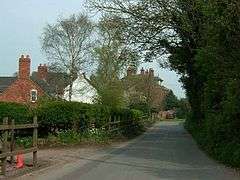Almington
Almington is a small village in Staffordshire, England. It is about 2 miles (3.2 km) east-northeast of Market Drayton by road, to the northwest of the villages of Hales and west of Blore Heath. Historically the manor and Almington Hall belonged to the Pandulf family, and much later, the Broughton family.
| Almington | |
|---|---|
 Almington Village | |
 Almington Location within Staffordshire | |
| OS grid reference | SJ7034 |
| Shire county | |
| Region | |
| Country | England |
| Sovereign state | United Kingdom |
| Post town | Market Drayton |
| Postcode district | TF9 |
| Dialling code | 01630 |
| Police | Staffordshire |
| Fire | Staffordshire |
| Ambulance | West Midlands |
| UK Parliament | |
History
Almington, also referred to as "Almentone",[1] was mentioned in the Domesday Book of 1086, when it belonged to the Pantulf family.[2] It is described as containing "3 hides "with appendages,” land for 6 ploughs, two acres of meadow and a wood two leagues long and one league wide (six miles by three miles)". The manor of Almington was larger than William Pandulf's Creswell, Derrington and Moddershall manors.[3]
In 1811, Samuel Lewis stated that the township of Almington had a population of 340 people.[4] In 1834, Peter Stray Broughton was stated to be the owner and lord of the manor of Almington, but Lieutenant-Colonel Dawes occupied Almington Hall.[5] It remained in the Broughton family, and in 1913 it belonged to John Lambert Broughton who resided at Almington Hall.[6]
Geography
Almington is about 2 miles (3.2 km) east-northeast of Market Drayton by road, and west of the small town of Loggerheads. It lies to the northwest of the villages of Hales and west of Blore Heath. Pinfold Lane leads out of the village and connects Almington to the A53 road (Newcastle Road). The River Tern flows to the west of the village.[7] Almington belongs to the parish of Market Drayton, once known as "Drayton in Hales", in the Hundred of Firehill, along with the hamlets of Blore Heath, Hales and Tirley.[8]
Geological studies of the area have revealed that Almington has coarse sandstones, red or pinkish brown in colour, with few or no pebbles in places, though there is a gravel pit in the vicnity with many.[9]
References
- "Collections for a History of Staffordshire: Vol. I". William Salt Archaeological Society. Houghton and Hammond. 1880. p. 227.
- Meisel, Janet (1974). "The Lives of Obscure Men: A Study of Three Baronial Families on the Welsh March, 1066-1272". University of California, Berkeley. p. 169.
- Meisel, Janet (1980). Barons of the Welsh Frontier: The Corbet, Pantulf, and Fitz Warin Families, 1066-1272. University of Nebraska Press. pp. 82–3.
- Lewis, Samuel (1811). "A Topographical Dictionary of England". p. 35.
- White, William (1834). "History, Gazetteer, and Directory of Staffordshire". p. 630.
- "Walford's County Families of the United Kingdom". 1913. p. 153.
- Almington, Google Maps, Retrieved 28 March 2020.
- "The English Counties Delineated: Or, A Topographical Description of England". Moule, Thomas. 1837. p. 100.
- "Memoirs: Explanation of Sheet. England and Wales". H.M. Stationery Office. 1927. p. 66.